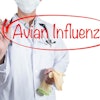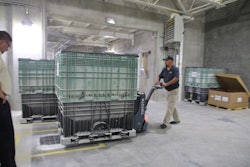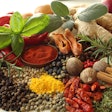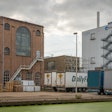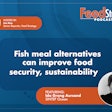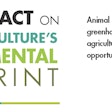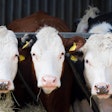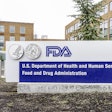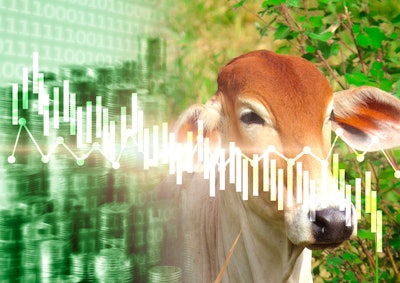
Kansas State professor leads global animal health project (22:07)
Ann Reus:Hello and welcome to the Feed Strategy podcast. I’m your host, Feed Strategy senior reporter Ann Reus. My guest today is Dustin Pendell, a professor in the department of agricultural economics atKansas State University。Pendell was recently named head of the Americas region of theCollaborating Center for the Economics of Animal Health。This is a five-year project supported by the World Organisation for Animal Health, which aims to develop decision-making tools and improve communication on the economic impacts of animal disease, ultimately improving the health of those animals.
Hi Dustin, thanks for being here.
Dustin Pendell:Thank you for having me today.
Reus:Congratulations on your new role. Can you explain what you’ll be doing at the Collaborating Center for the Economics of Animal Health?
Pendell:Yes, and thank you. So, I guess I’ll describe it a little bit, kind of the background, how we got to this point, I guess you can say. And so you indicated that Kansas State University and our collaborating partners, were awarded a Collaborating Center for the Economics of Animal Health. Myself and a colleague at Washington State University, we’ve actually been talking about this idea for three or four years now. And then back in February, March of 2022, I was contacted by somebody from the World Organization for Animal Health, or WOAH, as it’s called, and they asked about the possibility of submitting a proposal to run a Collaborating Center for Economics of Animal Health in the Americas region. And so the Americas region, as defined by this organization, this global animal health organization, is comprised of 33 countries in North America, Central America, South America and the Caribbean islands. And so that’s just a little background of how we got to where we are today.
And then, recently, about three weeks ago, K-State announced that we were awarded this center. And so kind of where are we going from here, I think we’re still trying to figure that out, since it’s so new. But kind of as the head of the center, you know, some of the day-to-day kinds of things, at least initially, I’m in charge of, I’m the point person for the World Organization for Animal Health, or WOAH. And so, they’ve reached out to me a few times for this or that, and so I’ve had to be that go-to person for the rest of our collaborators. And when we have to do annual reports and stuff like that, I’ll be the one that compiles all that.
到目前为止,两周半K-Statenounced that we’ve had this center, I’ve had one phone call the other day that somebody needed help with something and so I just kind of redirected them to who they could be in contact with, because it wasn’t necessarily an economist they needed to talk to, it was it was a non-economist, and so I can kind of point to direct people, resources, etc. I had somebody last week also visit about a research proposal to do some work in Chile, in farmed salmon. I’ve had actually two other people reach out to me here in the United States also about collaborating on research projects. And again, one of those times they needed an economist, so I was able to help. The other two, I was actually able to direct them to other individuals who might be better to suit their needs. And so that’s some of the stuff I’ve done so far, just in the last two, two and a half weeks, kind of the day-to-day.
Where I’m hoping we get to is more of the strategic kind of vision, the strategic plan, with our collaborating partners, once we come up with this plan together, and then I’ll help implement that. And you know, where I’ll be working with leaders in the various governments, whether it’s USDA, or the Brazilian government, your animal health officials, working with industry leaders, leaders of various producer groups, etc. So that’s where I hope that we’ll eventually get to once we can start to get past this newness of this idea, this center, and start to get to work.
But all that said, I’m still a faculty member at Kansas State University. I’ve got my teaching appointment, I’ve got my research appointment, and I got my extension appointment. And so I’m still going to be doing those things. Now with probably just a much more narrow focus, right. So a lot of this is all going to tie back to some kind of economics and animal health, animal disease.
Reus:Can you give a few examples of the economic impacts of animal health – good or bad?
Pendell:是的。所以我有我给你一个例子then I’ll talk about a couple of real-life examples that we’ve seen here in the U.S. and globally, good and bad. So I was involved in a project that looked at the unintentional release of a foot-and-mouth disease virus from the National Biodefense Facility. And we worked with a large team of engineers, meteorologists, veterinary, epidemiologist, economists, statisticians. biologists, etc., etc. And so then what we did, this project, was, if we had an accidental release of foot-and-mouth disease – and sofoot-and-mouth diseaseis a highly contagious disease that impacts cloven-hooved animals, so think cattle, swine, goats, sheep, deer – so if we had this foot-and-mouth disease outbreak here in the United States, a hypothetical example, we had a meteorologist that modeled how it would get in the atmosphere, the humidity, the wind speed, and how it would carry. And then our veterinary epidemiologist would model the spread of the disease, they need to know the prevalence rates, the transmission of the disease, etc., through animals or human-to-animal contact. And then we as economists would model economic impacts.
OK, and so then, now we’re getting to some of these good and bad economic impacts. An example, if we had a very small animal disease outbreak and small might mean in duration, it’s very short, and very few animals are depopulated or culled, what would happen is we would lose international trade. So now you can imagine if we would lose export market access for U.S. beef and U.S. pork, right, we do export quite a bit of beef and pork. And so now, if that beef and pork had to stay domestically, because we lost international markets, what that’s going to do is we’re going to have more that product in the U.S. and so what we’ll see at the retail level, the grocery stores, for example, prices would fall. And so, if you’re a consumer of these products, beef, pork as an example, all of a sudden, you go to the grocery store, and you’re paying lower prices for products, so that’s a win. So as a consumer, you could win, it can be good for you. Now, somebody’s winning, somebody’s got to lose, right? And so who’s losing? Well, it’s going to be the producers right? Now all of a sudden, there’s not as much demand for your products. And so what’s going to happen is, there’s going to be lower prices for those live animals at the producer level. And so what we would see is what we saw, what we would see, I guess, in a hypothetical example is, in a small outbreak, producers would lose more generally, probably, and consumers would be better off. OK, so that would be a small outbreak.
An example we saw in thehighly pathogenic avian influenzain 2014-2015 outbreak in Iowa, say, rural Iowa. What we did, what we saw was, there were teams of people that came in to help depopulate barns of birds, and clean up and dispose, etc. And so what that did was, that brought people to these rural towns, and these people from outside had to stay in hotels. So hotels were full. Well, those people in the evenings had to go eat somewhere. So they went out to the restaurants or they went to the grocery store and bought groceries. And so what we saw was some of these rural communities that were being impacted, layers were being impacted. We saw some of the non-agriculture such as hotels, restaurants, your mom-and-pop shops, stores, etc., they actually had a higher demand for their goods and services. And so they actually were better off. Now, let’s take the producers, right. If they weren’t getting indemnity payments, or if the indemnity payments were really small, what we saw, those would be your individuals that would lose. So that would be an example of a real-life scenario.
这是另一个例子口蹄疫disease project. You’ve got beef producers, you’ve got swine producers, versus grain producers, OK. And what we saw was, when we have a disease outbreak, and a big disease outbreak that might last more than four quarters or more than a year, we lose international trade, we have to cull large number of animals or depopulate a large number of animals. When you do that, now all of a sudden if you have fewer swine, you have fewer cattle to feed, well guess what? We don’t need as much feed for those animals, right? And so what happens? The demand for your feedstuff goes down, prices go down. And the losses, producers, crop producers were actually some of the biggest losers in that foot-and-mouth disease example.
Now, switching that real quick to kind of a real-life example, right, we saw in, what was it 2018, 2019, African swine fever outbreak in China, where they had to depopulate a significant amount of their live animals, swine. And so what happened to U.S. exports for hog feed products like soy beans, sorghum? It went down, right, the demand, the international demand for U.S. soybeans and sorghum went way down, because they didn’t need the feed to feed their hogs. And so what happens if fewer people need or demand our products? The prices fall.
And so those are some examples of what we did in hypothetical modeling scenarios. But then we can also talk about what happened in real-life with these outbreaks. And so there are going to be winners, there are going to be losers in these various scenarios. And it can be by species, it can be producers versus consumers, or anybody else along the supply chain. Or it can be grain farmers, such as your corn, your soybeans, your sorghum, wheat, etc. And so there’s going to be winners, there’s going to be losers. And there’s a lot of moving parts that are moving all at the same time and so you’ve just got to take your time and just kind of step through all those various actors and various players in the livestock industry to figure out who’s going to win, who is going to lose and then trying to figure out by how much. And so that’s what we as a center are trying to do to help governments, to help animal health officials, to help the industry, the producer groups such that they can be better prepared for such events.
Reus:All that said, what do you see as the biggest risk when it comes to economic well-being in this industry and why?
Pendell:你带一些疾病,我们有口蹄疫说ease, right? Last time we had a foot-and-mouth disease here on the mainland us I think was 1929. Maybe it was 1950s in Canada or Mexico. So it’s been a while since we’ve had a foot-and-mouth disease outbreak. Just as an example. Obviously, weather, we talk about drought, especially here in Kansas recently, we’ve had worse the drought out west for the last couple of years. You have a lot of volatile markets, whether it’s the corn or the feedstuff markets or the actual livestock markets. You know, that’s a huge risk, I think. We’ve seen a lot of labor issues since post-COVID, right. So there’s a kind of a human capital possible risk, do you have the employees? So I think there’s a lot of risks in agriculture, in the livestock space, whether that’s finance, whether its production, whether it’s market risks, production, I’m also including the animal disease. I just think there’s a lot of risk out there. And I think a producer needs to think about these risks, they need to plan accordingly. There’s lots of different risk-reducing, risk mitigation tools available, whether that be the futures markets, or forward contracts, or diversifying your crops or livestock that you plan to grow, things like that. But I just think the producer needs to think about all these risks associated with their own operation or business and they need to plan accordingly.
Reus:Yeah, there’s a lot to think about. So this new project is a five-year project. What will the arc of the project look like over those five years?
Pendell:第一,我们要如何改进我们的方法we estimate animal disease and animal health burdens and where did these burdens occur, at what point along the supply chain, whether that’s producer whether that’s the feedlots, or the processors, consumers. Who the biggest burden? What are some of the causes and risk factors of these? So that’s our one first objective. The second one is we’re trying to improve access to and we’re trying to standardize this animal disease and animal health burden information. So hopefully we’re going to collect more data, better, higher-quality data, and then we want to package that and put that together so that’s available for anybody that wants to download it and use it for their business management decisions. And finally, the third thing is we want to improve the capacity to interpret and use animal disease and health burden information.
So in other words, the way I think about this is it’s kind of like a land grant university, right, we’ve got three kind of missions: research, teaching and extension. And so this particular center, I view this as a lot of applied research. And when we take this research and apply it, we’re going to extend that to the necessary stakeholders, whether it’s a producer, group, a government, animal health officials, so that they can take this information and hopefully make a better decision, whether that’s on their own operation, whether that’s for the country for like, an animal health policy, or whatever it is. And so those are the three main goals I guess you can say that we have. And then if you go online and look at our proposal, there’s actually a five-year work plan that kind of talks about what we want to do, who we want to work with, those kinds of things that are a lot more specific examples, I guess.
Reus:You’ve said that, in order for this project to be successful, it will need to include veterinarians, epidemiologists and others. Talk about what you hope that collaboration across disciplines will look like.
Pendell:Oh, absolutely. And so, just taking a step back, when I was a student in college, which a long, long time ago, as an economist, I worked on teams with ag engineers, agronomists, soil scientists, etc. Because if you want to solve complex problems that deal with animal diseases, or any kind of problem that’s complex, climate change, etc., you can’t be siloed and just have an economist working on it, or you can’t be siloed just have a veterinarian or a human health individual, right? When we think about diseases, animal diseases, which could be animal only, or they could be zoonotic, where it’s both animal and human, it takes a lot of people to come together to help try to either control, mitigate, eradicate, prevent these kinds of diseases. And so it’s going to take veterinary epidemiologists, it’s going to take possibly human health epidemiologists, I envision engineers, right, people who do modeling, some of this simulation modeling, computer scientists, data scientists who can build infrastructure to store, house data, dashboards, etc. Of course, economists will look at the economics, but it’s going to take a whole team of people, depending on what your issue is what you’re looking at, to try to address some of these complex problems that we hope to address it with this center.
This collaborative center, I think I forgot to mention it, there’s five universities that are kind of the key collaborators: you’ve got Kansas State University, Washington State University, you have University of Sao Paulo, which is in Brazil, the University of Brasilia, which is also in Brazil. And then there is a university in Mexico called National Autonomous University of Mexico. And so we are comprised of both economists and veterinary epidemiologists at these universities. And so specifically here at K-State, we have economists, we have veterinarians, we have epidemiologists as part of the K-State team. And I envision where we’ll continue to extend into other disciplines like computer engineering, mechanical engineering, industrial engineering, etc., as we start to address some of the issues and problems.
Reus:I think you partially answered this next question, but how do you expect the findings of this project to affect different parts of the supply chain?
Pendell:So yeah, there’s, I guess, depending on what the issue is, who we’re working with, etc., there definitely will be different impacts along the supply chain. And so I’m not sure that we’re going to work with individual producers per se, in every single country and all over trying to address a specific issue on their operation. But if we can think about, OK, we’re trying to eradicate a disease, let’s say, brucellosis in Brazil, as an example. We need to figure out what’s the prevalence rates, how do you treat it, how can we try to do this? What are all those costs associated with doing that, but what would the benefits be? And if we can do that, we can then say, OK, go back to the producer, in this example maybe cow-calf producers, and then explain to them, show them, OK if you were to do this, you might be able to gain access to traditional markets, domestically or internationally, and this is what could happen with the prices. And this is ultimately what the benefit could be. And oh, by the way, here’s what the costs are right? And so we can demonstrate that to that particular group.
Now, we put in maybe in a slightly different context, the same problem, but maybe it’s a different economic modeling framework, we then can say, OK, if the cow-calf producers are going to benefit, cost benefit by this much, how does that translate to the next level, whether that’s maybe a feedlot or maybe it’s the producer or the packing plant, the slaughterhouses? How does that translate into additional international trade or domestic consumer demand? And then you’ve got a lot of, as we economists would say, we get a lot of supply and demand curves shifting throughout the entire supply chain. And so producers all along the supply chain all the way your final consumers, there are going to be various impacts, right, as we discussed earlier, some could lose, some could win, some could win by more than others. And so it will, every example, I guess, every project will probably be a little different on scope of the stakeholder along the supply chain, who were trying to help or target and then the results could vary depending on the issue, depending on a lot of factors in that particular country or setting.
Reus:Well, thank you so much, and best of luck on this new endeavor.
Pendell:Thank you very much.
Reus:You’ll have to come back in five years to give us an update at the end of the project.
Pendell:Absolutely. Look forward to it.
Reus:You can find out more about the Collaborating Center for the Economics of Animal Health atwoah.org。谢谢你听。我安Reus饲料trategy.




